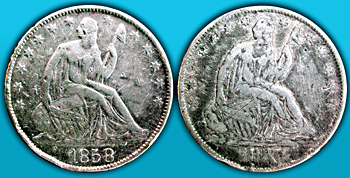Beware Buying Coins at Swap Meets, Garage Sales
|
"Making Cents"
The Signal
Saturday, October 1, 2005
| R |
As a general rule, one would not expect to find bargain-priced rare coins at a swap meet. Even vendors who set out a tray of coins priced at $1 each will "salt" their tray with fakes and fantasies of no value.
Some of these fakes include 1847 Hawaiian one-cent coins; 99.99 percent of the time they are modern made brass replicas of the genuine and very scarce original cent. Bawdy-house brass tokens seem to be found even at garage sales; again, there are no such real tokens. They are just brass fantasies, worth a few cents each for the brass content alone.
Real coins sometimes are counterstamped with all sorts of imprints — initials, mottoes, icons and even phrases. In almost all cases, they are worthless numismatic items and no one should pay any premium over face value for the coin. Some are made to resemble something old, such as a Civil War motto or emblem or the name of an old company. A common fantasy is to stamp a coin with the name of a territory (before statehood) such as "Denver, Colorado Territory, 1874."
Among the commonly offered altered or counterfeit coins found at swap meets and such venues are 1877 Indian head cents, 1909-S Indian head cents, 1914-D Lincoln cents, 1922 no-mint mark cents, 1913 Liberty head nickels, 1916-D Mercury dimes, 1932-D and 1932-S quarters, 1928 Peace dollars (which can be made from a 1928-S Peace dollar, which is not very scarce), and almost all gold coins.
Unless a gold coin offered for sale by a private party is part of a bracelet or necklace, chances are it is not a genuine coin. Anyone with real gold coins can sell them to any coin dealer for a fair market price. Dealers usually are alert enough not to buy counterfeit coins — although some expertly made counterfeits have fooled dealers, as well. Such coins are usually peddled through non-numismatic channels such as garage sales, newspaper ads and swap meets.
From the responses to this column, it is evident that some fantasies and counterfeits have found their way into private hands. A commonly told story is about travelers in foreign countries shopping at antique stores and finding trays of various real and fake coins for a standard price per tray, such as $5 per coin. The real coins are usually worth a fraction of $5, while the fakes are worth nothing at all.
There are exceptions — but they are for the lucky, experienced collector.
At an antique shop in Bombay in 1970 I asked to see all their American coins. They were in a tray priced at about $1 per coin (7 rupees each). Most were wheat cents, dateless buffalo nickels and worn Mercury dimes. However, a few of the buffalo nickels were in Extra Fine to nearly Uncirculated condition, including a 1914-D. Naturally, I bought all of the latter. Most of the coins I saw at other shops around the world were overpriced real and fake coins.
Often tourists wishing to give someone a gift from their travels will buy fake "ancient" coins in Greece or some Mideastern country.
At an antique stall in Dubrovnik in Croatia in 1980 I found a display of 13th-century Croatian dinars for sale at about $10 U.S. each. I asked how often they sold. The owner replied, not very often, but they are very scarce (which I knew). He offered me all he had at about $8 U.S. each. I later resold them in Los Angeles at several times that price. If they were fake, he'd sell many at $1 each to tourists. But they are very small silver coins and not that attractive — except to collectors.
I later learned that a hoard was unearthed at a new housing project in Zagreb a year or so earlier, and many found their way into antique shops and private collections. The rest were on display at a museum in Zagreb.
If you are a tourist with limited numismatic knowledge, take along a collector before buying any coin or token that is supposed to be scarce or valuable.
Dr. Sol Taylor of Sherman Oaks is president of the Society of Lincoln Cent Collectors and author of The Standard Guide to the Lincoln Cent. Click here for ordering information.
©2005, THE SIGNAL · ALL RIGHTS RESERVED.
